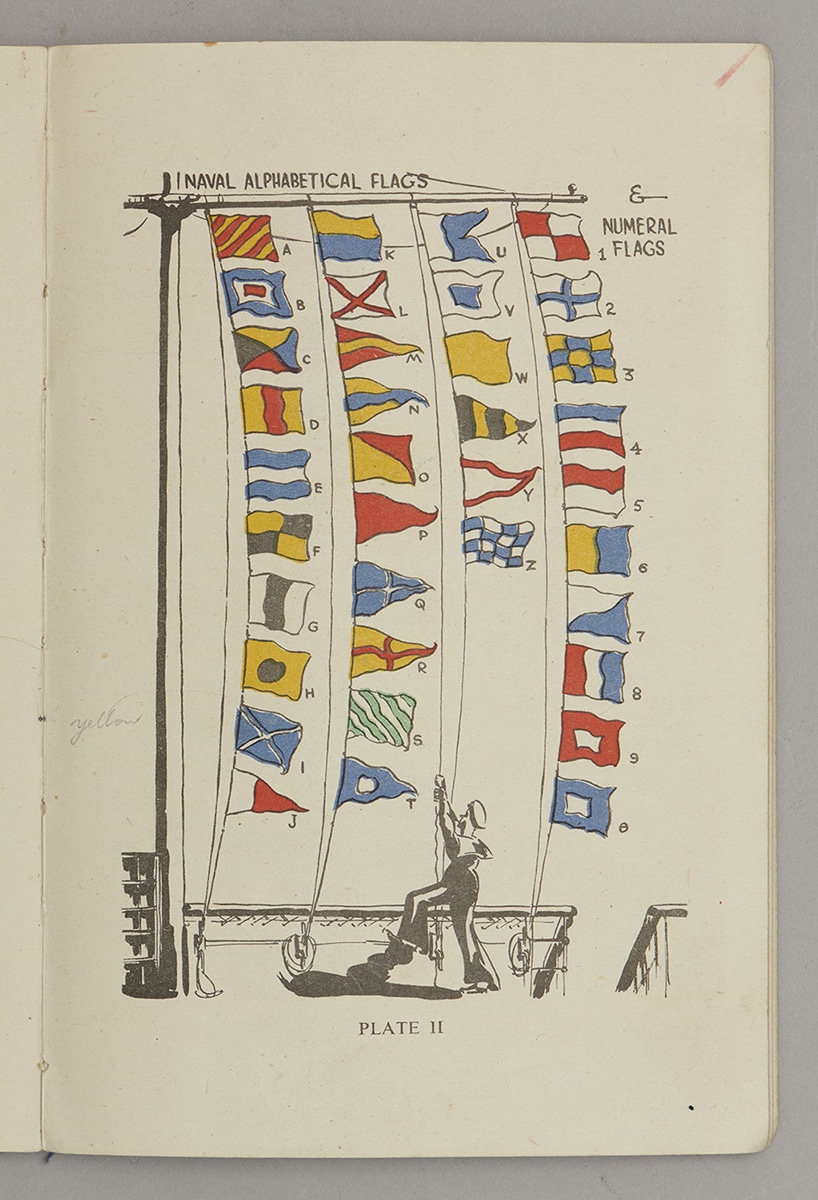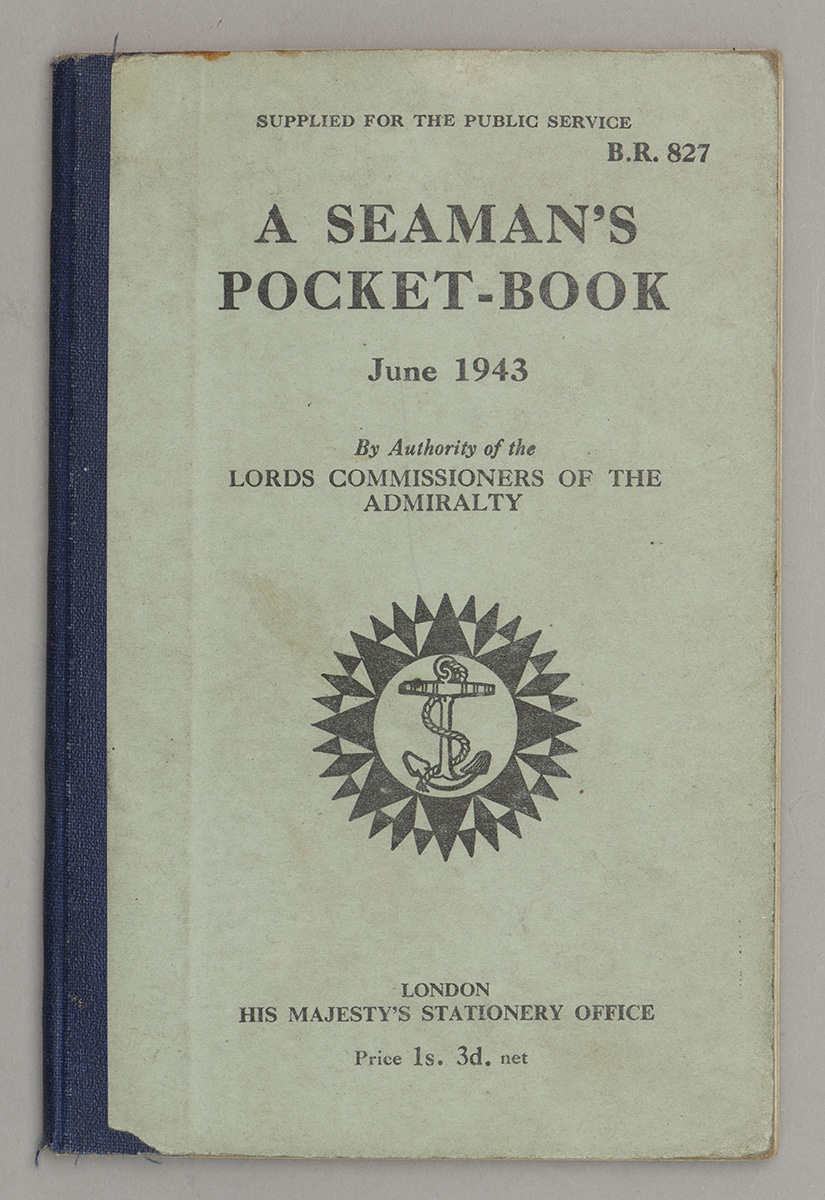A page from the Seaman’s Pocket-Book 1943 shows communication flags used by the Navy. Some flags represent letters of the alphabet, some flags represent numbers. These are different from the flags used by the Navy today. National Museum of the Royal New Zealand Navy. BAP 0021_001, BAP 0021_004.
National Museum of the Royal New Zealand Navy
Based in Auckland, New Zealand, Torpedo Bay Navy Museum is the official museum of the Royal New Zealand Navy.

- Visit
- Explore
- By Collections
- ShipsNew Zealand’s naval ships have undertaken a range of tasks and operations. Read about ‘HMNZS Gambia’ – the ship known to have fired the last shots of WWII and ‘HMHS Maheno ‘– a hospital ship that carried injured men back home to New Zealand in WWI.
- Ship Items
- Artefact Unpacked
- Clothing
- Photographs
- Medal Collection
- PlacesRead about the history of ‘Elizabeth House’ -the home of the Women in the Navy during WWII and ‘HMNZS Tamaki’ – a training establishment for personnel in WWII.
- Art & Ephemera
- Oral HistoriesThe Oral History Project commenced in 1991 as part of the celebrations for the 50th Anniversary of the Royal New Zealand Navy. The oral histories include veterans’ memories from as early as WW1 and include personal stories of naval personnel recently returned from duties in Bosnia, Afghanistan, Cambodia, East Timor and the Sinai. Oral history is an important method of collecting unique and personal recollections – historical evidence that might otherwise be lost forever. The recorded and transcribed interviews help to create a fuller understanding of our past. These testimonials provide a unique insight into the naval life of men and women during war and peace. The recounting of the testimony can be emotional for an interviewee who may never have discussed the details of his or her experiences with anyone before. The Museum takes great responsibility in handling these unlocked memories.
- By Themes
- Pre World War One
- World War One
- Inter War Years
- World War Two
- Post War – 1970
- 1970 – Today
- Technology & weaponsThe Royal New Zealand Navy has a long history of technology and weaponry including radar, torpedoes and minesweeping. Read about the history of NZ Coastal Defences and Enemy Operations in NZ Waters.
- Customs & TraditionsThe Navy is steeped in customs and tradition and these play an important role in Navy life today. Find out what naval terms like “Splice the Mainbrace” mean and read about Mascots in the Navy – including HMS New Zealand’s mascot- a bulldog named Pelorus Jack
- AviationRead about military air power in both the Royal Navy and the Royal New Zealand Navy. Included are details about the modern and currently active Seasprite Helicopters.
- By Collections
- Learn
- About
- Store
- Hire a venue
- Donate
- Contact us
- Visit
- Explore
- By Collections
- ShipsNew Zealand’s naval ships have undertaken a range of tasks and operations. Read about ‘HMNZS Gambia’ – the ship known to have fired the last shots of WWII and ‘HMHS Maheno ‘– a hospital ship that carried injured men back home to New Zealand in WWI.
- Ship Items
- Artefact Unpacked
- Clothing
- Photographs
- Medal Collection
- PlacesRead about the history of ‘Elizabeth House’ -the home of the Women in the Navy during WWII and ‘HMNZS Tamaki’ – a training establishment for personnel in WWII.
- Art & Ephemera
- Oral HistoriesThe Oral History Project commenced in 1991 as part of the celebrations for the 50th Anniversary of the Royal New Zealand Navy. The oral histories include veterans’ memories from as early as WW1 and include personal stories of naval personnel recently returned from duties in Bosnia, Afghanistan, Cambodia, East Timor and the Sinai. Oral history is an important method of collecting unique and personal recollections – historical evidence that might otherwise be lost forever. The recorded and transcribed interviews help to create a fuller understanding of our past. These testimonials provide a unique insight into the naval life of men and women during war and peace. The recounting of the testimony can be emotional for an interviewee who may never have discussed the details of his or her experiences with anyone before. The Museum takes great responsibility in handling these unlocked memories.
- By Themes
- Pre World War One
- World War One
- Inter War Years
- World War Two
- Post War – 1970
- 1970 – Today
- Technology & weaponsThe Royal New Zealand Navy has a long history of technology and weaponry including radar, torpedoes and minesweeping. Read about the history of NZ Coastal Defences and Enemy Operations in NZ Waters.
- Customs & TraditionsThe Navy is steeped in customs and tradition and these play an important role in Navy life today. Find out what naval terms like “Splice the Mainbrace” mean and read about Mascots in the Navy – including HMS New Zealand’s mascot- a bulldog named Pelorus Jack
- AviationRead about military air power in both the Royal Navy and the Royal New Zealand Navy. Included are details about the modern and currently active Seasprite Helicopters.
- By Collections
- Learn

